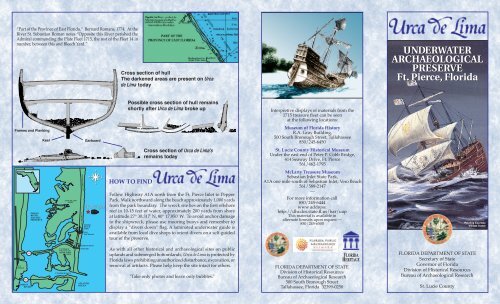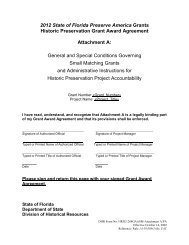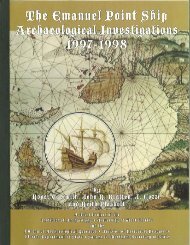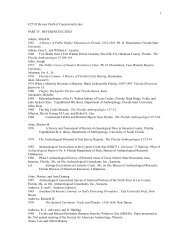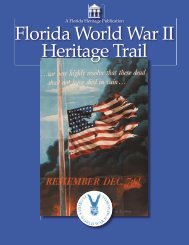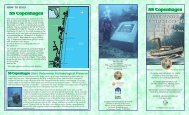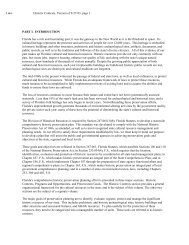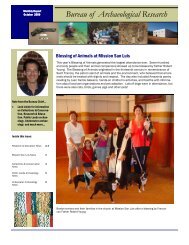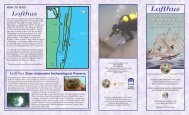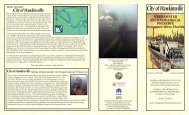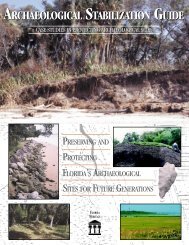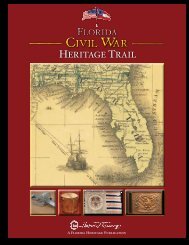UNDERWATER ARCHAEOLOGICAL PRESERVE Ft. Pierce, Florida ...
UNDERWATER ARCHAEOLOGICAL PRESERVE Ft. Pierce, Florida ...
UNDERWATER ARCHAEOLOGICAL PRESERVE Ft. Pierce, Florida ...
- No tags were found...
You also want an ePaper? Increase the reach of your titles
YUMPU automatically turns print PDFs into web optimized ePapers that Google loves.
“Part of the Province of East <strong>Florida</strong>.” Bernard Romans, 1774. At theRiver St. Sebastian Roman notes “Opposite this River perished theAdmiral commanding the Plate Fleet 1715, the rest of the Fleet 14 innumber, between this and Bleech Yard.”Cross section of hullThe darkened areas are present on Urcade Lima today<strong>UNDERWATER</strong><strong>ARCHAEOLOGICAL</strong><strong>PRESERVE</strong><strong>Ft</strong>. <strong>Pierce</strong>, <strong>Florida</strong>Possible cross section of hull remainsshortly after Urca de Lima broke upInterpretive displays of materials from the1715 treasure fleet can be seenat the following locations:Frames and PlankingKeelGarboardMuseum of <strong>Florida</strong> HistoryR.A. Gray Building,500 South Bronough Street, Tallahassee850/245-6450Cross section of Urca de Lima'sremains todaySt. Lucie County Historical MuseumUnder the east end of Peter P. Cobb Bridge,414 Seaway Drive, <strong>Ft</strong>. <strong>Pierce</strong>561/462-1795INDIANRIVERAQUATIC<strong>PRESERVE</strong>JACK ISLANDPARK6/10 MA1A NORTH BEACH1,000 YDS ➞➞PEPPERBEACHPARKUDTSeal MuseumHOW TO FINDFollow Highway A1A north from the <strong>Ft</strong>. <strong>Pierce</strong> Inlet to PepperPark. Walk northward along the beach approximately 1,000 yardsfrom the park boundary. The wreck site lies on the first offshorereef in 10-15 feet of water, approximately 200 yards from shoreat latitude 27° 30.317' N, 80° 17.950' W. To avoid anchor damageto the shipwreck, please use mooring buoys and remember todisplay a “divers down” flag. A laminated underwater guide isavailable from local dive shops to orient divers on a self-guidedtour of the preserve.McLarty Treasure MuseumSebastian Inlet State Park,A1A one mile south of Sebastian Inlet, Vero Beach561/589-2147—For more information call850/245-6444www address:http://dhr.dos.state.fl.us/bar/uapThis material is available inalternate formats upon request —850/245-6500Painting CourtesyWilliam TrotterFT.PIERCEA1AA1AINDIANRIVERFT. PIERCEINLET STATERECREATIONAREAFT. PIERCE INLET➞Radisson ResortStop LightATLANTICOCEANAs with all other historical and archaeological sites on publicuplands and submerged bottomlands, Urca de Lima is protected by<strong>Florida</strong> laws prohibiting unauthorized disturbance, excavation, orremoval of artifacts. Please help keep the site intact for others."Take only photos and leave only bubbles."FLORIDA DEPARTMENT OF STATEDivision of Historical ResourcesBureau of Archaeological Research500 South Bronough StreetTallahassee, <strong>Florida</strong> 32399-0250<strong>Florida</strong>HeritageFLORIDA DEPARTMENT OF STATESecretary of StateGovernor of <strong>Florida</strong>Division of Historical ResourcesBureau of Archaeological Research—St. Lucie County
She was built strong, heavily planked to ridethrough ocean swells. Urca de Lima (named after herowner Miguel de Lima y Melo), was part of a Spanishmerchant convoy commanded by Capitán General DonJuan de Ubilla. She was also known as the Nao de Refuerzo,perhaps because she had been reinforced for theAtlantic trade routes. Urcas were flat-bottomed, roundbelliedstoreships originally designed to ply the shallowwaters off the Flemish coast. Due to their cargo carryingcapacity, they soon were adopted for the Spanish-Americantrade between Europe and the New World.Loaded with the products of Mexico and Manila,Ubilla’s flota of ships rendezvoused in the summer of1715 with the South American squadron of Antoniode Echeverz at Havana to begin the long voyage backto Spain. The combined fleet of eleven vessels set sailfrom Cuba on the 24th of July, assisted in their northerlycourse through the Canal de Bahama by the Gulf Stream.But they were never to reach the open ocean.Only a few days out, the flota was struck by a fiercehurricane off the coast of <strong>Florida</strong>. Miguel de Lima laterdescribed what happened:“The sun disappeared and the wind increased in velocitycoming from the east and east northeast. The seas became verygiant in size, the wind continued blowing us toward shore,pushing us into shallow water. It soon happened that we wereunable to use any sail at all, making bare our yards, mostlydue to the wind carrying away our sails and rigging, and wewere at the mercy of the wind and water, always driven closerto shore. Having then lost all of our masts, all of the shipswere wrecked on the shore, and with the exception of mine,broke to pieces. We lost only thirty seamen and marines, whowere carried away by waves while in the waist of the ship. Myship is at Palmar de Ays in 27 degrees and 15 minutes at themouth of a river.”Grounded by the storm, but left relatively intact,Urca de Lima provided survivors from the other wreckedships with victuals from her stores until supplies finallyarrived from Havana thirty-one days later. In the meantime,the castaways began to bury their dead and collectwhat valuables they could from debris washed ashore.“On these deserted beaches, which were very barren anddry, God permitted us to find sweet water, enough to drink,by making wells the height of a man, which were called “casimbas.”However, all of the survivors were not able to survivethe temperament of those shores, the heat of the sun was insufferable,and the number of mosquitoes were probably greaterthan the plague. Thanks to God all of the silver on my ship hasescaped [has been recovered].”The Urca had been heavily laden with general cargo,which included hundreds of uncured cowhides, packetsof chocolate, vanilla, sassafras, incense, and other exoticproducts which brought high prices in Europe. Unlikeother ships in the stricken flota, she carried no royal treasure,only private silver in sacks and chests. It was probablyher stout hull that had saved much of her contentsfrom being dashed away in the storm. She was the firstof the fleet wrecks to be salvaged by Spanish crews fromHavana, but was then burned to the waterline to concealher position from English freebooters, who also began toarrive at the scene. Although many precious goods wererecovered from the wrecksites shortly after the disaster,salvage attempts soon ended as turbid sand engulfed theremnants of the lost ships and their cargos.Some fifty years later marine surveyor Bernard Romanswas sent to <strong>Florida</strong> to map the little-known coastlinefor the British Crown. When he reached the beachesof “Palmar de Ais,” his survey crew found the remains ofan old shipwreck inshore of the shifting sand bars at themouth of an inlet. It was Urca de Lima. The men collectedSpanish coins on the beach and lived on turtle eggs andbear meat as they completed mapping the region.Reports from the coast between Sebastian and <strong>Ft</strong>.<strong>Pierce</strong> inlets in the early 1800s indicate that the ships ofthe 1715 fleet were known to have been lost in that area.However, in 1837 John L. Williamspublished the Territoryof <strong>Florida</strong>, a book that gainedwidespread popularity butmistakenly placed the locationof the 1715 wrecks in the<strong>Florida</strong> Keys—an error that Northwest Mooringwould continue on “treasure”maps published as late as the1960s. By 1892 the original inletat <strong>Ft</strong>. <strong>Pierce</strong> had filled withsediment and had becomepart of the present beach.The wreck of Urca de Limaonce again was forgotten.Then, in 1928 an adventurernamed William J. BeachAnchorarrived in <strong>Ft</strong>. <strong>Pierce</strong> with talesof man-eating sharks andSpanish gold. Equipped withhard-hat diving gear and ametal detecting device, he ledcity officials to the ballast pileof Urca de Lima, the first of theSouthwest Mooringfabled 1715 fleet shipwrecksto be rediscovered. As manyas sixteen cannons and fouranchors were raised from thewreck site, some of which can still be seen today in frontof the <strong>Ft</strong>. <strong>Pierce</strong> City Hall. Word of the wreckage spread,and in 1932 the first salvage permit was issued to searchfor and to recover Spanish treasure.Urca de Lima was heavily salvaged but, since mostof her cargo had been recovered by the Spaniards,modern salvage efforts were only marginally successful,producing only one silver bar, two silver wedges,and five iron cannons. The silver wedges gave rise tothe site’s modern nickname, the Wedge Wreck. In 1983and 1984 the last salvage permits were granted on Urcade Lima. In 1985 Urca de Lima’s surviving hull structurewas carefully mapped and recorded by archaeologists atthe request of city officials who wanted an underwaterpark. Urca de Lima was designated <strong>Florida</strong>’s first Under-FLORIDA BUREAU OF <strong>ARCHAEOLOGICAL</strong> RESEARCHMarker BuoyUrca de Lima Bronze PlaqueKeel TrenchMain StructureURCA DE LIMAFT. PIERCE, FLORIDACannon SpillSoutheast Mooringwater Archaeological Preserve in 1987; popularity of thepreserve paved the way for subsequent preserves aroundthe state. Urca de Lima was listed on the National Registerof Historic Places in 2001.FEET10 20[


